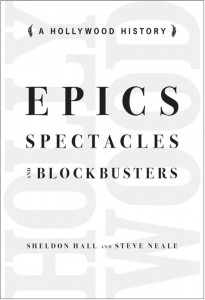Epics, Spectacles, and Blockbusters
Epics, Spectacles, and Blockbusters: A Hollywood History by Sheldon Hall and Steve Neale (Wayne State University Press, 2010). 363 pages. ISBN: 978-0814330081 (paperback), £31
 About the reviewer: Julian Stringer is Associate Professor in Film and Television Studies University of Nottingham and is currently researching the cultural politics of location filmmaking as well as several projects related to East Asian cinema. He is the editor of Defining Cult Movies: The Cultural Politics of Oppositional Taste (2003, Manchester University Press); Movie Blockbusters (2003, Routledge); with C-Y Shin, New Korean Cinema (2005, Edinburgh University Press); with A. Phillips, Japanese Cinema: Texts and Contexts (2007, Routledge); Wong Kar-Wai’s ‘In the Mood For Love’ (Hong Kong UP, 2012).
About the reviewer: Julian Stringer is Associate Professor in Film and Television Studies University of Nottingham and is currently researching the cultural politics of location filmmaking as well as several projects related to East Asian cinema. He is the editor of Defining Cult Movies: The Cultural Politics of Oppositional Taste (2003, Manchester University Press); Movie Blockbusters (2003, Routledge); with C-Y Shin, New Korean Cinema (2005, Edinburgh University Press); with A. Phillips, Japanese Cinema: Texts and Contexts (2007, Routledge); Wong Kar-Wai’s ‘In the Mood For Love’ (Hong Kong UP, 2012).
The study of Hollywood’s large-budget, large-scale, high-visibility movie juggernauts – what in contemporary parlance are currently called ‘blockbusters’ – is by now an accepted part of the Film Studies curriculum, a way of introducing students to concepts like the New Hollywood and Global Hollywood. However, consideration of the US film industry’s policy of engineering such products so as to foreground technological developments, showcase new aesthetic characteristics, upgrade exhibition arrangements and maximise profit potential is frequently neglected in scholarly investigations of ‘Old Hollywood’. This substantial monograph by two leading film historians provides students and researchers with a fresh approach to this important topic as well as a large amount of new information on one hundred years of American movie history.
 Across the book’s eleven painstakingly researched and closely argued chapters, Sheldon Hall and Steve Neale trace a century of high-end film production in the US. Their focus is multi-dimensional. Epics, Spectacles and Blockbusters summarises intensive research into aspects of production, distribution, exhibition, aesthetics and consumption, taking into consideration significant technological innovations such as sound, widescreen and digital. Innumerable films are discussed, ranging from familiar objects of academic scrutiny such as Gone with the Wind (1939) and Jaws (1975) to more critically overlooked examples of popular commercial filmmaking like A Midsummer Night’s Dream (1935) and Pearl Harbor (2001). The result is a pioneering and comprehensive account of a certain tendency in Hollywood cinema.
Across the book’s eleven painstakingly researched and closely argued chapters, Sheldon Hall and Steve Neale trace a century of high-end film production in the US. Their focus is multi-dimensional. Epics, Spectacles and Blockbusters summarises intensive research into aspects of production, distribution, exhibition, aesthetics and consumption, taking into consideration significant technological innovations such as sound, widescreen and digital. Innumerable films are discussed, ranging from familiar objects of academic scrutiny such as Gone with the Wind (1939) and Jaws (1975) to more critically overlooked examples of popular commercial filmmaking like A Midsummer Night’s Dream (1935) and Pearl Harbor (2001). The result is a pioneering and comprehensive account of a certain tendency in Hollywood cinema.
The authors’ chosen method is to tell this particular history through analysis of industry discourse found in the film trade press, especially Variety. The book’s strengths all grow out of this key decision. Hall and Neale’s empirically grounded approach yields original insights that allow new narratives of knowledge and understanding to be constructed. For example, paying close attention to the language through which Variety, among other sources, has discussed and described historical change provides a means of tracking the shifts in terminology associated with such developments. In turn, this way of proceeding promises to enhance comprehension of the inter-locking nature of Hollywood as a mature business practice by highlighting how and why aspects of production are contingent upon factors linked to distribution and exhibition. Close analysis of scenes from selected movies capture these developments through practical example and have obvious classroom application.
 Learning on Screen
Learning on Screen